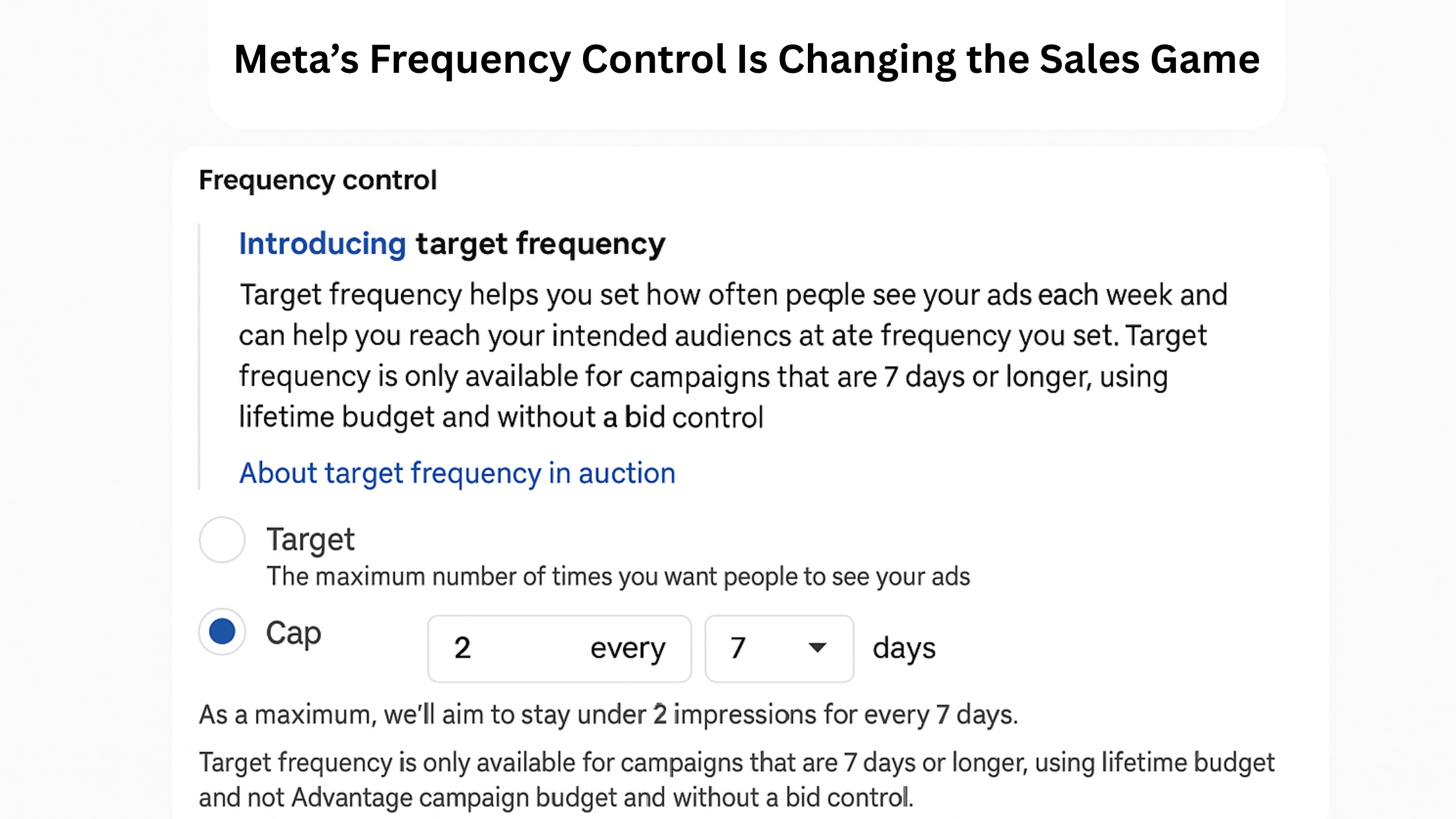
Meta has launched a powerful new tool for advertisers: Target Frequency for Sales Campaigns. Rolled out in early 2025, this feature lets you control how often your ads appear to users – helping reduce ad fatigue and improve performance. If your campaigns suffer after a few views or you’ve seen frequency spikes with minimal spend, this could be a game-changer.
In this blog, we’ll break down how Target Frequency works, its pros and cons, and how to use it effectively – plus key insights and best practices for today’s ad landscape.
Meta’s Target Frequency feature allows advertisers to set the average number of times their ads are shown to each person in their target audience on a weekly basis. Unlike the traditional “Frequency Cap,” which sets a hard limit on impressions, Target Frequency aims for an average, giving Meta’s algorithm flexibility to balance reach and repetition.
This feature is particularly valuable for Sales campaigns, where maintaining audience engagement without overwhelming them is critical for driving conversions.
Ad fatigue is a well-documented issue in digital advertising. Research shows that after just 4 views, ad performance can drop by as much as 60%. This means your ad might not be underperforming because of poor creative – it could simply be shown too often to the same people.
With Target Frequency, you can now control this in Sales campaigns, not just Reach objectives, giving you more precision in how your ads are delivered.
To use Target Frequency, your campaign must meet specific criteria, and you’ll need to configure it in Meta’s ad manager. Here’s a breakdown of the requirements and setup process.
To give you a clearer picture, here’s where the provided image fits into this blog. The screenshot below shows Meta’s Frequency Control interface, highlighting the Target Frequency settings.
Meta’s Frequency Control Interface
Caption: Meta’s Frequency Control interface allows you to set a target frequency (e.g., 2 times every 7 days) and a cap to manage ad exposure effectively. Placement Recommendation: Place this image right after the “Setup Process” subsection to visually illustrate how advertisers can configure Target Frequency in Meta’s ad manager.
Target Frequency offers several advantages, particularly for advertisers focused on Sales objectives. Here’s how it can transform your campaigns:
These benefits make Target Frequency a powerful tool for advertisers looking to maximize their Sales campaign outcomes.
While Target Frequency is promising, it comes with limitations and potential drawbacks that advertisers should be aware of:
Some industry experts, like Jon Loomer, caution that restricting Meta’s algorithm too much could lead to worse results (Jon Loomer Digital). The algorithm is designed to optimize for performance, and imposing strict frequency limits might hinder its ability to find the best audience segments. This suggests that while Target Frequency has potential, its effectiveness may vary, and testing is crucial.
To make the most of this feature, follow these best practices:
A retailer running a Sales campaign for a new product line sets a Target Frequency of 3 times every 7 days. Initially, engagement and conversions rise, but after two weeks, performance declines due to overexposure. Reducing the frequency to 2 times every 7 days improves metrics, highlighting the importance of fine-tuning frequency settings for optimal results.
As of April 10, 2025, Meta’s Target Frequency feature is poised to reshape how advertisers approach Sales campaigns. By addressing ad fatigue and enhancing creative testing, it offers a more controlled and efficient way to deliver ads. However, its effectiveness will likely depend on how advertisers adapt and test within their specific contexts.
Looking ahead, we can expect further refinements to this feature, potentially expanding its compatibility with other campaign types or targeting options. Industry discussions will also continue to evolve, providing deeper insights into best practices and potential pitfalls.
Aspect | Details |
Campaign Type | Lifetime campaign, 7+ days duration |
Budget | Lifetime budget required |
Compatibility | Not compatible with cost/bid control, A+ audiences |
Frequency Setting | Set average views per week (e.g., 2 times/7 days) |
Benefits | |
– Ad Fatigue Prevention | Reduces 60% performance drop after 4 views |
– Creative Testing | Ensures fair exposure for testing variants |
– Budget Optimization | Reaches new audiences, reduces wasted impressions |
– Performance Enhancement | Higher engagement and conversion rates |
Meta’s Target Frequency feature for Sales campaigns is a significant step forward for advertisers. By giving you control over ad frequency, it helps prevent fatigue, improves creative testing, and optimizes your budget for better results. However, its limitations and potential controversies mean it’s not a one-size-fits-all solution. Testing and monitoring are key to finding the right balance for your campaigns.
If you’re running Sales campaigns with a lifetime budget and want to reduce ad fatigue, Target Frequency is worth exploring. Start with a conservative approach, monitor your metrics, and adjust as needed to unlock its full potential.